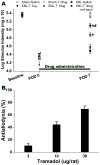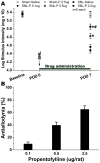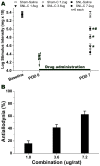Tramadol and propentofylline coadministration exerted synergistic effects on rat spinal nerve ligation-induced neuropathic pain
- PMID: 24009718
- PMCID: PMC3756942
- DOI: 10.1371/journal.pone.0072943
Tramadol and propentofylline coadministration exerted synergistic effects on rat spinal nerve ligation-induced neuropathic pain
Abstract
Neuropathic pain is an intractable clinical problem. Drug treatments such as tramadol have been reported to effectively decrease neuropathic pain by inhibiting the activity of nociceptive neurons. It has also been reported that modulating glial activation could also prevent or reverse neuropathic pain via the administration of a glial modulator or inhibitor, such as propentofylline. Thus far, there has been no clinical strategy incorporating both neuronal and glial participation for treating neuropathic pain. Therefore, the present research study was designed to assess whether coadministration of tramadol and propentofylline, as neuronal and glial activation inhibitors, respectively, would exert a synergistic effect on the reduction of rat spinal nerve ligation (SNL)-induced neuropathic pain. Rats underwent SNL surgery to induce neuropathic pain. Pain behavioral tests were conducted to ascertain the effect of drugs on SNL-induced mechanical allodynia with von-Frey hairs. Proinflammatory factor interleukin-1β (IL-1β) expression was also detected by Real-time RT-PCR. Intrathecal tramadol and propentofylline administered alone relieved SNL-induced mechanical allodynia in a dose-dependent manner. Tramadol and propentofylline coadministration exerted a more potent effect in a synergistic and dose dependent manner than the intrathecal administration of either drug alone. Real-time RT-PCR demonstrated IL-1β up-expression in the ipsilateral spinal dorsal horn after the lesion, which was significantly decreased by tramadol and propentofylline coadministration. Inhibiting proinflammatory factor IL-1β contributed to the synergistic effects of tramadol and propentofylline coadministration on rat peripheral nerve injury-induced neuropathic pain. Thus, our study provided a rationale for utilizing a novel strategy for treating neuropathic pain by blocking the proinflammatory factor related pathways in the central nervous system.
Conflict of interest statement
Figures






Similar articles
-
Depressing interleukin-1β contributed to the synergistic effects of tramadol and minocycline on spinal nerve ligation-induced neuropathic pain.Neurosignals. 2014;22(1):30-42. doi: 10.1159/000355071. Epub 2013 Oct 23. Neurosignals. 2014. PMID: 24157594
-
Combination of tramadol with minocycline exerted synergistic effects on a rat model of nerve injury-induced neuropathic pain.Neurosignals. 2013;21(3-4):184-96. doi: 10.1159/000338049. Epub 2012 Sep 7. Neurosignals. 2013. PMID: 22964800
-
Propentofylline, a glial modulating agent, exhibits antiallodynic properties in a rat model of neuropathic pain.J Pharmacol Exp Ther. 2001 Jun;297(3):1210-7. J Pharmacol Exp Ther. 2001. PMID: 11356948
-
Elucidation of pathophysiology and treatment of neuropathic pain.Cent Nerv Syst Agents Med Chem. 2012 Dec;12(4):304-14. doi: 10.2174/187152412803760645. Cent Nerv Syst Agents Med Chem. 2012. PMID: 23033930 Review.
-
Spinal interleukin-10 therapy to treat peripheral neuropathic pain.Neuromodulation. 2012 Nov-Dec;15(6):520-6; discussion 526. doi: 10.1111/j.1525-1403.2012.00462.x. Epub 2012 Jun 1. Neuromodulation. 2012. PMID: 22672183 Free PMC article. Review.
Cited by
-
The nitroxyl donor, Angeli's salt, reduces chronic constriction injury-induced neuropathic pain.Chem Biol Interact. 2016 Aug 25;256:1-8. doi: 10.1016/j.cbi.2016.06.009. Epub 2016 Jun 7. Chem Biol Interact. 2016. PMID: 27287419 Free PMC article.
-
Effect of intraperitoneally administered propentofylline in a rat model of postoperative pain.Korean J Pain. 2020 Oct 1;33(4):326-334. doi: 10.3344/kjp.2020.33.4.326. Korean J Pain. 2020. PMID: 32989197 Free PMC article.
-
Interaction between NMDA and CB2 function in the dorsal hippocampus on memory consolidation impairment: an isobologram analysis.Psychopharmacology (Berl). 2017 Feb;234(3):507-514. doi: 10.1007/s00213-016-4481-9. Epub 2016 Nov 17. Psychopharmacology (Berl). 2017. PMID: 27858086
-
Human bone marrow-derived and umbilical cord-derived mesenchymal stem cells for alleviating neuropathic pain in a spinal cord injury model.Stem Cell Res Ther. 2016 Mar 8;7:36. doi: 10.1186/s13287-016-0295-2. Stem Cell Res Ther. 2016. PMID: 26957122 Free PMC article.
-
Revisiting Tramadol: A Multi-Modal Agent for Pain Management.CNS Drugs. 2019 May;33(5):481-501. doi: 10.1007/s40263-019-00623-5. CNS Drugs. 2019. PMID: 31004280 Review.
References
-
- Wrzosek A, Obara I, Wordliczek J, Przewlocka B (2009) Efficacy of tramadol in combination with doxepin or venlafaxine in inhibition of nociceptive process in the rat model of neuropathic pain: an isobolographic analysis. J Physiol Pharmacol 60: 71–78. - PubMed
-
- Brattwall M, Turan I, Jakobsson J (2010) Pain management after elective hallux valgus surgery: a prospective randomized double-blind study comparing etoricoxib and tramadol. Anesth Analg 111: 544–549. - PubMed
-
- Alvarez P, Saavedra G, Hernandez A, Paeile C, Pelissier T (2003) Synergistic antinociceptive effects of ketamine and morphine in the orofacial capsaicin test in the rat. Anesthesiology 99: 969–975. - PubMed
-
- Cavazzini F (2008) The combination acetominophen/tramadol in hematological daily practice. Minerva Med 99: 631–641. - PubMed
Publication types
MeSH terms
Substances
LinkOut - more resources
Full Text Sources
Other Literature Sources
Miscellaneous

